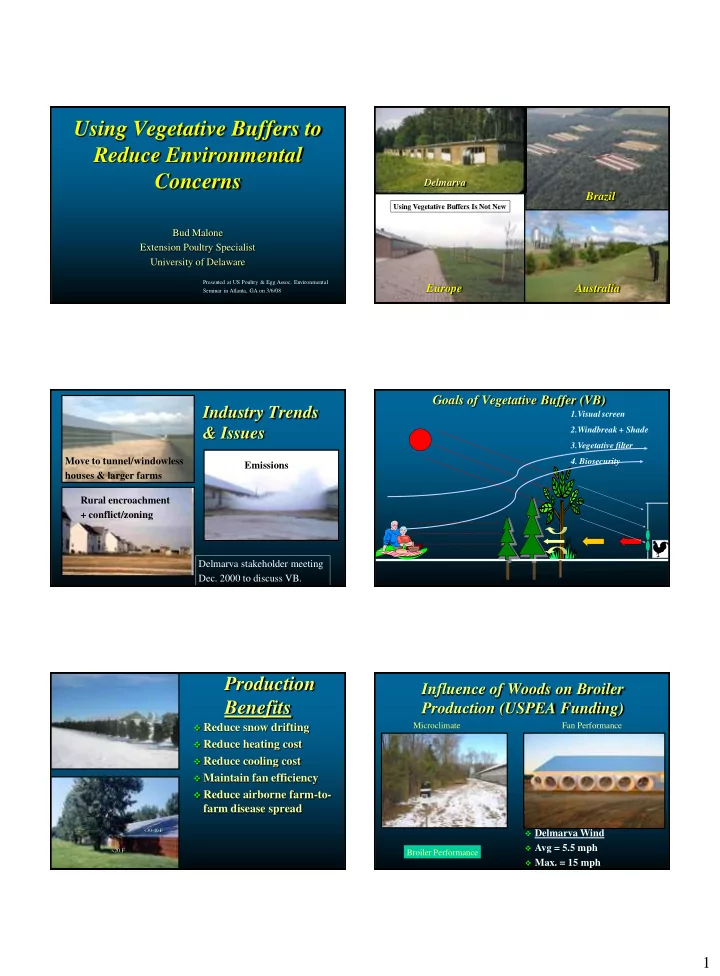

Using Vegetative Buffers to Reduce Environmental Concerns Delmarva Brazil European Tree Programs Using Vegetative Buffers Is Not New Bud Malone Extension Poultry Specialist University of Delaware Presented at US Poultry & Egg Assoc. Environmental Europe Australia Seminar in Atlanta, GA on 3/6/08 Goals of Vegetative Buffer (VB) Industry Trends 1.Visual screen & Issues 2.Windbreak + Shade 3.Vegetative filter Move to tunnel/windowless 4. Biosecurity Emissions houses & larger farms Rural encroachment + conflict/zoning Delmarva stakeholder meeting Dec. 2000 to discuss VB. Production Influence of Woods on Broiler Benefits Production (USPEA Funding) Microclimate Fan Performance Reduce snow drifting Reduce heating cost Reduce cooling cost Maintain fan efficiency Reduce airborne farm-to- farm disease spread <30-40 F Delmarva Wind Avg = 5.5 mph <20 F Broiler Performance Max. = 15 mph 1
VB to Reduce Backpressure VB Design Considerations for Poultry Farms. on Fans 15 mph wind = 15.5% reduction in fan cfm N & 4.4% increase in W E amperage. S Design Considerations: VB blocks winds and Increase porosity (>spacing, deciduous trees, shrubs) on prevailing summer wind side of farms. aids in maintaining Increase density (<spacing, evergreens, multiple rows) optimum fan on winter wind side and opposite fans efficiency. Bioaerosol Transfer Between Reduce Air-Borne Disease Transmission: Houses on Same Farm Roadway and Farm-to-Farm LT spread on Delmarva (Johnson, et.al. 2001) Distance from LT farm not as important as direction of wind from that farm Downwind farms 4 times more likely to get LT N-S oriented houses 40% more likely to get LT than E-W houses Conventional houses 3 ½ more likely to get LT than tunnel houses VB = 16% less aerobic bacteria aerosols Preliminary results suggest VB reduces aerosol bacteria by ~16% Environmental Benefits Test Site for Measuring Efficacy of Vegetative Buffers Reduce ammonia, dust and odor Reduce runoff Reduce groundwater nitrates Convert CO 2 to O 2 30’ Low cost program to partially address Planted March 2002: 8’ 10’ future air quality & emissions challenges Bald cypress 16 ft high Leyland cypress 14 ft Red cedar 8 ft high EPA/DNREC 319 funding 2
VB Opposite Tunnel Fans “Reduced” Wind direction and crop (porosity) behind VB “appears” to influence odor reduction Wind Speed (99%), Dust (57%), Ammonia (55%) and Odor (27%) Years with soybeans = 28% less odor Years with corn = little change in odor X X 22 ft 2002-2007 data Better odor dispersion if VB near the source (50’vs200’) 42 sample days Effect of VB on Ground Water Quality Nitrate-N (ppm) in Test Wells 7 -20% 1 5 6 3 Preliminary data suggest 5 VB reduced nitrates by 20% 4 as groundwater moves 3 from up gradient to down 2 gradient the poultry farm . 1 UD Poultry House 4 6 2 0 UG VB DG House DG VB Six wells sampled spring and fall from 2004 to 2007 Potential for Carbon Credits and Neighbor Relations Benefits: Biomass? Creates positive image Landscape appearance & increase property value Blocks view of houses, waste facilities and routine farm activities Out-of-Sight-Out-of Mind!! Attractive farms have less odor ( Mikesell, et. al., 2001) Reduces odor, dust, feathers, noise, etc. 3
Examples of Neighbor Issues Dust From Fans Visual Pollution Delmarva Neighbor Relations Trends Increasing number of nuisance complaints and more stringent zoning ordinance. DPI survey: ~ 40% complaints are dust/feathers, 40% odor & 20% visual, noise, etc. Odor From Farm Value of New Houses Direction and location of tunnel ventilation a major issue. DPI developed a proactive industry neighbor policy, VB a major component of the BMPs. Fragrant Shrubs &Trees to Mask Odor? VB Implementation Challenges Design VB For Each Side of Each Farm with a Goal to Best to Design and Implement Tree Plan Meet ALL Objectives – Tree Selection is Critical BEFORE Building Poultry Houses! South North West East 4
VB Distance from Fans Form of Plan Material to Use is Important • Fan efficiency decreased <4 times fan diameter Bare root = high mortality • Plume distance 10 times fan diameter • Plantings near maximum plume distance, add for more fans at each location. Cuttings require water Containers better option B&B costly/ plant shock Limited Information on Planting Maintenance and Care Essential Trees Between Houses Insects Weed Control Irrigation Potential for VB with Few Years Summary Emission reductions encouraging, continue to better define this program. Provides a long-term, low-cost, partial solution to emerging industry issues (maybe one of the most cost-effective BMP’s). Neighbor relations has driven interest in VB. 5
Summary (cont.) Growers need technical assistance in designing, implementing and maintenance of VB. Cost-share programs available in some states. Delmarva poultry industry committed to VB for farms – hired a coordinator to implement this program. 6
Recommend
More recommend